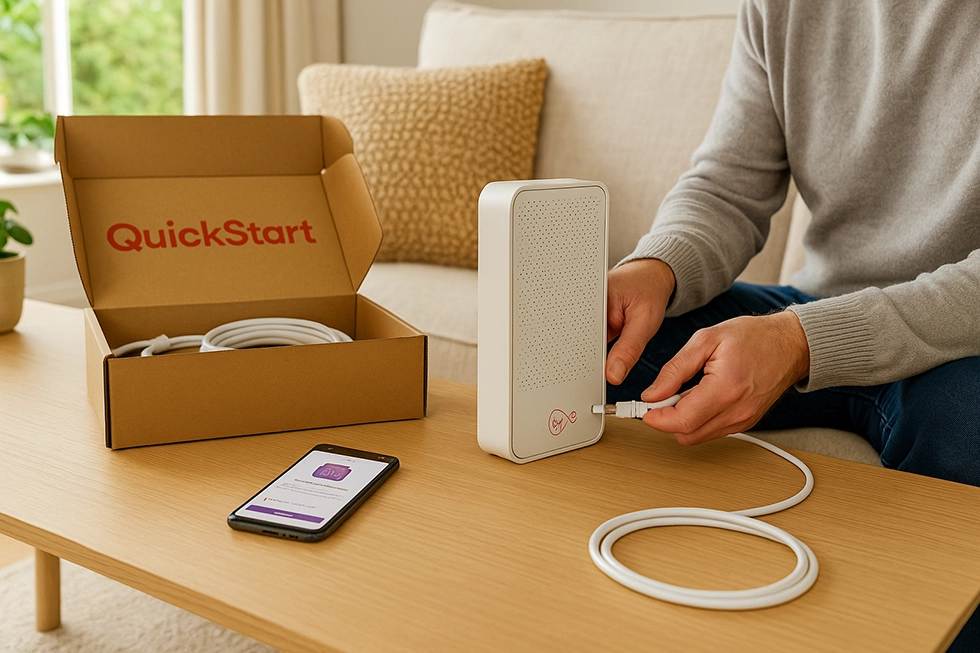Summary
- ISPA chair Steve Leighton warns full fibre take-up is stuck at about 15% despite high gigabit and FTTP coverage.
- He says years of “fibre broadband” marketing, low trust in altnet brands and a confusing market are putting people off switching.
- He links slow adoption to digital exclusion: cost and devices, patchy availability, and low digital skills or awareness.
- He argues consolidation can help altnets gain scale, but only if it improves customer experience.
- His fixes include clearer, benefit-led marketing, a national digital skills push and a more joined-up approach to affordability and equipment access.
Full fibre coverage in the UK is expanding quickly, but the number of people actually signing up to fibre-to-the-premises (FTTP) services is growing much more slowly. Steve Leighton, Chair of the Internet Service Providers’ Association (ISPA) and Strategic Advisor for fibre supplier Altnets, has set out how he thinks the broadband sector should respond – and why the next phase needs to focus as much on adoption as on new build.

Coverage is high, but take-up is still low
The UK now looks well served by fast broadband. Gigabit-capable networks pass close to nine in ten premises, and full fibre coverage is estimated at just under four in five homes and businesses. Government-backed programmes such as Project Gigabit are still pushing those numbers higher, with a long-term goal of reaching 99% of premises by 2032.
The picture looks very different once you move from coverage to take-up. Recent analysis quoted by Leighton suggests that, across the industry, the average FTTP penetration rate is only about 15%, up from roughly 12% in 2023. In simple terms, that means most properties that could upgrade to full fibre have not yet done so.
For network builders – especially alternative networks that have borrowed heavily to roll out parallel infrastructure – that gap matters. They are laying fibre past millions of doors, but only a small share of households are switching onto those new connections. Rising build costs and higher interest rates make that imbalance even more uncomfortable.
Why households are not rushing to full fibre
Leighton’s starting point is that this is not just a pricing or availability problem. In his view, public understanding and perception are at the heart of the issue.
For over a decade, many providers have marketed fibre-to-the-cabinet (FTTC) packages as “fibre broadband”, even though the final stretch from the street cabinet to the home still runs over older copper cables. That has created a long-term expectation problem. When a full fibre provider turns up and talks about “upgrading to fibre”, many customers reasonably assume they already have it.
Brand familiarity is another barrier. The UK is still dominated by long-standing names, and many people have been with the same provider for years. Newer altnets may offer faster speeds or keener pricing, but they often have lower brand recognition and little track record in the eyes of local residents. Leighton argues that worries over reliability, customer service and the risk of something going wrong during a switch are still putting off a large number of households.
On top of that, the current market can feel bewildering. A single postcode might be covered by the Openreach network, one or two altnet fibre operators, Virgin Media’s network and multiple ISPs reselling across them. Each can have different prices, contract terms and features. For many consumers, that level of choice feels like complexity rather than empowerment, and sticking with the status quo can seem easier than trying to unpick it all.
Digital exclusion: money, geography and skills
Leighton frames the adoption problem within a wider digital exclusion story, split into three strands: economic, geographic and educational.
Economic exclusion covers households that simply cannot afford the connectivity or equipment they need. Ofcom and government research has repeatedly highlighted that millions of households are under pressure from communications bills, and about 1.9 million households are estimated to struggle with broadband costs. Social tariffs offer cheaper options for people on certain benefits, but awareness and take-up of those tariffs remain low. Even where a discounted connection is available, families may still lack suitable devices or may share a single ageing handset or laptop between several people.
Geographic exclusion is the more familiar story of areas that still lack next-generation connectivity. While full fibre coverage has improved dramatically, there are still rural and hard-to-reach locations waiting for upgrades. For those homes, debates about FTTP adoption can feel distant, because the option simply is not there yet.
Educational exclusion is about confidence and skills. A House of Lords committee has previously estimated that more than ten million UK adults cannot complete a basic set of “foundation” digital tasks, such as logging into a device, connecting to Wi-Fi or managing simple online forms. For people in that position, the difference between FTTC and FTTP may feel irrelevant. If they are not comfortable using the internet for banking, government services or work, then paying more or switching provider for a faster connection is unlikely to be a priority.
Together, those factors help explain why fibre coverage alone does not guarantee fibre take-up. Even where a new network passes the door, people may not be able to pay, may not have the right devices or may not feel confident changing anything about how they get online.
When bigger fibre groups help – and when they don’t
Leighton also addresses consolidation, which is already a live topic as many altnets look for buyers, merger partners or fresh capital. His view is that consolidation can help by delivering the scale needed to improve operations, cut duplicated costs and attract long-term investment.
However, he warns that consolidation is not automatically positive. If mergers lead to confused branding, weaker customer service or painful migration processes, then the entire sector could suffer. Any decline in the way customers experience full fibre – whether during a network handover or in the months afterwards – risks undermining trust, slowing adoption and damaging the hard-won reputation that fibre builders have started to build.
There is also a consumer-facing tension. Over time, well-managed consolidation could simplify a market that currently feels fragmented and confusing, with many overlapping networks and ISPs. In the short term, though, households in affected areas may have to navigate changes to billing, support channels or contract terms, which can add to uncertainty rather than remove it.
Explaining full fibre in plain English
One of Leighton’s main proposals is a shift in how the industry talks about full fibre. Instead of leading with semi-technical terminology and a long list of figures, he argues that providers should focus on everyday benefits.
That means explaining how full fibre can make home working more reliable, keep video calls clear when the rest of the family is streaming, or give small businesses more dependable access to cloud tools. It also means linking better connectivity to broader outcomes such as stronger local economies, improved access to services and more resilient communities.
He is critical of marketing that leans heavily on jargon and headline numbers without explaining why they matter. The danger, he suggests, is that customers tune out when faced with yet another advert listing speeds and acronyms.
At the same time, many people still find speeds a useful shorthand when comparing packages. The challenge for providers is to balance clear, simple speed information with equally clear explanations of what those speeds enable in day-to-day life, rather than relying on numbers alone to carry the message.
National digital skills, not just local projects
Leighton’s second major recommendation is a national education push around next-generation connectivity. In his view, isolated local projects and short-term pilot schemes are not enough to tackle the scale of the skills gap and confidence gap he describes.
He calls for a coordinated campaign to help every community understand what full fibre and other gigabit-capable networks can actually do, backed up by ongoing digital skills support rather than one-off training sessions. That would mean working across central government, local authorities, education providers, charities and the broadband industry, with a focus on making sure people can keep up as services and devices change.
For example, support could range from basic “first steps online” courses in community centres, through to targeted help for older people, jobseekers or small business owners who want to make better use of digital tools. The key point is continuity: giving people somewhere to turn when they hit a barrier, rather than leaving them stuck after a single introductory course.
The cost problem and lack of devices
On affordability, Leighton argues that social tariffs are only part of the answer. Discounted broadband helps, but it does not solve the problem for households that lack the technology to use that connection fully or that face multiple overlapping costs.
He highlights the need for a more joined-up approach that looks at connectivity, devices and support together. That might include schemes to supply refurbished laptops and tablets, partnerships between ISPs and charities, or local projects that help families set up and maintain equipment safely.
There is already a patchwork of regional initiatives trying to address these issues, but Leighton believes there is a case for a more coherent national strategy. Without that, many households risk being left on the wrong side of a digital divide, even if full fibre passes their front door.
What this means for providers and customers
Taken together, Leighton’s comments underline a simple reality: the UK’s full fibre story can no longer be judged by coverage alone. The next phase is about getting people to use what has been built, and making sure they can benefit from it.
For altnets, that means focusing not just on construction targets but on trust, service quality and clear communication. They need to show that they are reliable, long-term partners rather than short-lived challengers. For larger incumbents, it means recognising that they also have a role in improving digital skills, promoting social tariffs and explaining upgrades in plain language.
For government and regulators, the message is that adoption and meaningful use now need as much attention as build-out. Targets for gigabit coverage are important, but they sit alongside questions about affordability, inclusion and the basic confidence to get online.
For broadband customers, the practical takeaway is more straightforward. If full fibre is available in your area, it is worth taking the time to understand what it offers and how it differs from older part-copper services. Checking availability, comparing offers from both incumbents and altnets, and looking into social tariffs or local skills support where relevant can help households make an informed choice rather than simply staying put.
The infrastructure race is well underway. The harder task now is making sure people can, and want to, use the networks that have been built.
